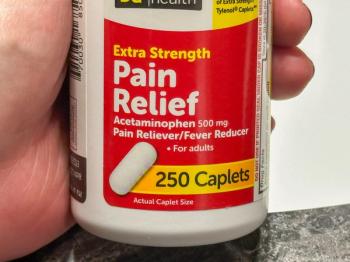
- April 2024
- Volume 90
- Issue 4
Case Study: Advise Patients on Eligibility, Efficacy of Zoster Vaccine

Sharing data and a personal recommendation can make a difference in a patient’s life
Shingles is a painful rash that can result in long-term effects, the most common being nerve pain (postherpetic neuralgia).1 Individuals develop shingles when the varicella-zoster virus, which causes chickenpox, reactivates in their bodies.2 There is a recombinant, adjuvanted vaccine (Shingrix; GSK) that helps protect against the shingles rash and is recommended for everyone 50 years or older as well as patients 19 years or older with compromised immune systems. It is administered in a 2-dose series, with doses spaced by 2 to 6 months.3
When it comes to recommending the zoster vaccine, every community pharmacist can think of a similar version of this interaction with a patient. A pharmacist recommends the shingles vaccine and asks the patient whether they would be interested in protecting themselves, but when the time comes for a decision, the patient opts to “think about it” or “just get it another time.” In most instances, the pharmacist will have future opportunities to engage this patient more effectively, but this is not always the case.
Patient RG is a 55-year-old man who frequently comes into the pharmacy. He is friendly and generally adherent to his medications. Today, he’s here for his cholesterol medication and annual influenza vaccine. The pharmacist reviews his vaccination record and realizes he has not received the zoster vaccine. As the pharmacist administers his influenza shot, they mention that the CDC recommends he be protected against shingles. The pharmacist informs RG that there is a vaccine that can help protect him, and RG jokingly says he has the pickleball court booked in half an hour and will maybe receive it another time. The pharmacist puts the bandage on RG’s arm, makes a mental note to reengage RG the next time he comes into the pharmacy, and sends him on his way.
A few months later, RG walks up to the pharmacy counter and the pharmacist assumes he’s there for the next refill of his cholesterol medication. Remembering the mental note to talk to RG about the shingles vaccine, the pharmacist walks over to restart the conversation. Upon approaching him, the pharmacist realizes something is different about RG; he doesn’t seem to be his usual happy self. The pharmacist asks him how he’s doing, and RG says he developed shingles about a month ago. The rash spread to his face and affected his vision, and he has lost partial vision in 1 eye.
For a pharmacist, hearing this news is devastating. Knowing there is a vaccine that could have prevented this is gut-wrenching. Should the pharmacist have done more to convince RG to be vaccinated? Was he engaged in the most effective way and with the best tools?
To start, the conversation about the shingles vaccine could have begun before the influenza vaccine was being administered. At this point, he was nearly done receiving his vaccine and was ready to move on to the next part of his day. When reviewing additional vaccine recommendations with patients, it is important to have a separate conversation dedicated solely to this matter. This way, the patient can focus on the importance of the recommendation and can take the time to process the information, evaluate it, and make their decision.
Next, although the pharmacist correctly referenced the CDC’s recommendation for the shingles vaccine, this may not have been the best way to phrase the recommendation. The CDC’s SHARE (share, highlight, address, remind, explain) method for recommending vaccines highlights using personal experiences to make recommendations more effective.4 In this case, rather than saying, “The CDC recommends…,” the pharmacist could say, “I recommend this vaccine for you because of your increasing risk that comes with age. The rash and long-term effects can be severe, and I want to protect you against that.” A pharmacist delivering a strong recommendation can make the difference between a patient being protected and remaining at risk.
Finally, during that initial encounter, the pharmacist could have provided RG with more information about his risk for shingles and the effectiveness of the vaccine. In this case, they could have said, “One in 3 adults will get shingles in their lifetime”1 or “About 10% to 18% of individuals who have shingles develop nerve pain that lasts for months or even years after the rash goes away.”1 The pharmacist could have also added that the shingles vaccine is 91% to 97% effective in preventing shingles and 89% to 91% effective at preventing long-lasting nerve pain.3 Providing patients with this information empowers them to make the decision to be vaccinated.
RG’s story should serve as a reminder to pharmacists that every vaccine engagement opportunity could be the one that makes an enormous difference in a patient’s life. Using effective techniques, being empathetic, and providing accurate information are the cornerstones to an effective vaccine recommendation. Keep these concepts in mind when counseling someone on the shingles vaccination, and don’t miss an opportunity to protect your patients.
About the Author
Adam James, PharmD, is manager for the Immunization Program and other clinical programs for Rite Aid Corporation. In his role, he provides Rite Aid’s 1750-plus locations with updates, education, and best practices to ensure the success of clinical programs.
References
1. About shingles (herpes zoster). CDC. Updated May 10, 2023. Accessed January 17, 2024. https://www.cdc.gov/shingles/about/index.html
2. Cause and transmission. CDC. Updated May 10, 2023. Accessed January 17, 2024. https://www.cdc.gov/shingles/about/transmission.html
3. Shingles vaccination. CDC. Updated May 8, 2023. Accessed January 17, 2024. https://www.cdc.gov/vaccines/vpd/shingles/public/shingrix/index.html
4. Make a strong influenza vaccine recommendation. CDC. Updated August 25, 2023. Accessed January 18, 2024. https://www.cdc.gov/flu/professionals/vaccination/flu-vaccine-recommendation.htm
Articles in this issue
over 1 year ago
April 2024 OTC Case Studies: Dry Eye Reliefover 1 year ago
Advocate for Greater Pharmacy Technician Rolesover 1 year ago
Accurate, Complete Data Entry Is Key to Medication Safetyover 1 year ago
Condition Watch: Asthmaalmost 2 years ago
Gap in Medicaid Impacts Access to Services for Justice-Involved Patientsalmost 2 years ago
Middletown Pharmacy and Wellness Staff Care for the Communityalmost 2 years ago
OTC Contraception Opens New Opportunities for Counseling PatientsNewsletter
Stay informed on drug updates, treatment guidelines, and pharmacy practice trends—subscribe to Pharmacy Times for weekly clinical insights.














































































































































































































